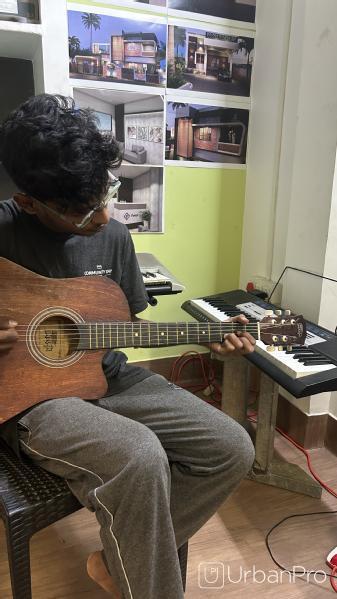
Mukkadal Dam Rd Thittuvilai, Thittuvilai, India - 629852
Details verified of Mapa School of Music✕
 Identity
Identity
 Education
Education
Know how UrbanPro verifies Tutor details
Identity is verified based on matching the details uploaded by the Tutor with government databases.





mapa school of music, Harris complex 1st floor, selection center,
balamore road,Thittuvilai
Mukkadal Dam Rd Thittuvilai, Thittuvilai, India - 629852
Landmark: 100 meter before from subam hospital
![]() Phone Verified
Phone Verified
![]() Email Verified
Email Verified
Report this Profile
Is this listing inaccurate or duplicate? Any other problem?
Please tell us about the problem and we will fix it.
Class Location
![]() Online (video chat via skype, google hangout etc)
Online (video chat via skype, google hangout etc)
![]() At the Institute
At the Institute
Age groups catered to
Below 10 yrs, 10 yrs to 15 yrs, Above 25 yrs, 16 yrs to 25 yrs
Class strength catered to
One on one/ Private Tutions, Group Classes
Class Location
![]() Online (video chat via skype, google hangout etc)
Online (video chat via skype, google hangout etc)
![]() At the Institute
At the Institute
Vocal Style taught
Western Singing, Carnatic Singing
Gender of teachers
Male tutor, Female tutor
Age group catered to
14- 21 years old, 5- 13 years-old, 22- 50 years old, Above 50 years
Class strength catered to
One on one/ Private Tutions, Group Classes
Proficiency level catered to
Beginner, Intermediate, Advanced
Class Location
![]() Online (video chat via skype, google hangout etc)
Online (video chat via skype, google hangout etc)
![]() At the Institute
At the Institute
Age groups catered to
10 yrs to 15 yrs, Above 25 yrs, 16 yrs to 25 yrs
Flute form taught
Carnatic flute, Hindustani flute
Class strength catered to
One on one/ Private Tutions, Group Classes
Class Location
![]() Online (video chat via skype, google hangout etc)
Online (video chat via skype, google hangout etc)
![]() At the Institute
At the Institute
Age groups catered to
Below 10 yrs, 10 yrs to 15 yrs, Above 25 yrs, 16 yrs to 25 yrs
Class strength catered to
One on one/ Private Tutions, Group Classes
Class Location
![]() Online (video chat via skype, google hangout etc)
Online (video chat via skype, google hangout etc)
![]() At the Institute
At the Institute
Age groups catered to
Below 10 yrs, 10 yrs to 15 yrs, Above 25 yrs, 16 yrs to 25 yrs
Genre
Classical, Western
Class strength catered to
One on one/ Private Tutions, Group Classes
Class Location
![]() Online (video chat via skype, google hangout etc)
Online (video chat via skype, google hangout etc)
![]() At the Institute
At the Institute
Genre of guitars taught
Classical, Electric, Other, Bass, Acoustic
Age groups catered to
Below 10 yrs, 10 yrs to 15 yrs, Above 25 yrs, 16 yrs to 25 yrs
Type of classes
Individual classes, Group classes
Music genres taught
Western Classical, Ukulele, Indian classical, Country Folk, Indian Film music, Rock & Roll, Jazz & Blues
Outcomes catered to
Learn to play as an accompaniment to singing, Formal training to earn certification for a particular music grade level, Learn basics of playing a guitar, Learn a specific song, Learn specific skills: Plucking, Chord progression etc
Ownership of equipment is compulsory
Yes
Class Location
![]() Online (video chat via skype, google hangout etc)
Online (video chat via skype, google hangout etc)
![]() At the Institute
At the Institute
Age groups catered to
Below 10 yrs, 10 yrs to 15 yrs, Above 25 yrs, 16 yrs to 25 yrs
Class strength catered to
One on one/ Private Tutions, Group Classes
Upcoming Live Classes
1. Which classes do you teach?
We teach Drums, Flute, Guitar, Keyboard (Music), Piano, Violin, Vocal Music and Western Vocal Music Classes Classes
2. Do you provide a demo class?
Yes, We provide a free demo class.
3. Where are you located?
We are located in Mukkadal Dam Rd Thittuvilai, Thittuvilai.
Answered on 15/07/2024 Learn Music/Instrumental Music/Piano
Answered on 15/07/2024 Learn Music/Instrumental Music/Piano
Remembering chords and scales on the piano can be a challenging but manageable task with the right approach and techniques. Here are some strategies that can help:
1. Understand the Theory
- Chords: Learn the structure of chords (major, minor, diminished, augmented, etc.). For example, a major chord consists of the root, major third, and perfect fifth.
Scales: Understand the interval patterns that make up different scales. For instance, a major scale follows the pattern of whole, whole, half, whole, whole, whole, half steps.
2. Practice Regularly
Repetition: Regularly practice playing chords and scales to build muscle memory.
- Hands Separate: Practice hands separately before putting them together to focus on finger placement and coordination.
3. Use Mnemonics
- Create mnemonic devices to remember the notes in a scale or the structure of a chord. For example, the C major scale (C-D-E-F-G-A-B) could be remembered with a phrase like "Cats Don't Eat Furry Green Apples Bare."
4. Visualize Patterns
Keyboard Geography: Familiarize yourself with the look and feel of the keyboard layout. Notice patterns, such as the grouping of black keys (2s and 3s).
Hand Shapes:Recognize and practice the hand shapes for common chords and scales.
5.Use Apps and Tools
- **Digital Tools**: Use piano learning apps and software that provide visual and interactive methods to practice chords and scales.
- **Flashcards**: Create or use pre-made flashcards to test your memory and reinforce learning.
6. Apply Music Theory in Practice
-Songs and Pieces: Incorporate chords and scales into pieces you're learning. Recognizing them in the context of a song can help reinforce your memory.
7. Group Practice
Chord Families: Practice chords in groups, such as all major chords, then all minor chords.
Scale Variants: Practice different variants of a scale together (e.g., natural, harmonic, and melodic minors).
Answered on 15/07/2024 Learn Music/Instrumental Music/Piano
1. "Islamey" by Mily Balakirev: Known for its extreme difficulty, it challenges pianists with rapid finger work and complex rhythms.
2. "La Campanella" by Franz Liszt: This piece is famous for its high jumps and fast passages, requiring exceptional dexterity and precision.
3. "Gaspard de la Nuit" by Maurice Ravel: Especially the movement "Scarbo," this piece is notorious for its technical and interpretative demands, with rapid changes and intricate passages.
4. "Opus clavicembalisticum" by Kaikhosru Shapurji Sorabji: Known for its extreme length and complexity, this piece is rarely performed due to its daunting technical challenges.
5. "Etudes" by György Ligeti: These modern etudes are extremely demanding, both technically and musically, requiring advanced skills and deep understanding.
6. "Transcendental Etudes" by Franz Liszt: A set of twelve etudes that are some of the most difficult works in the piano repertoire, each requiring virtuosic technique.
7. "Piano Sonata No. 2" by Charles-Valentin Alkan: Known for its technical challenges, it pushes the pianist's endurance and technical capabilities to the limit.
8. "Three Movements from Petrushka" by Igor Stravinsky: This work is technically demanding with its rapid finger work, wide leaps, and complex rhythms.
9. "Hammerklavier Sonata" (Sonata No. 29, Op. 106) by Ludwig van Beethoven: One of Beethoven's most difficult sonatas, it demands great technical prowess and interpretive skill.
10. "Godowsky's Studies on Chopin's Etudes": These studies are among the most challenging works ever written for piano, often considered unplayable by many.
Class Location
![]() Online (video chat via skype, google hangout etc)
Online (video chat via skype, google hangout etc)
![]() At the Institute
At the Institute
Age groups catered to
Below 10 yrs, 10 yrs to 15 yrs, Above 25 yrs, 16 yrs to 25 yrs
Class strength catered to
One on one/ Private Tutions, Group Classes
Class Location
![]() Online (video chat via skype, google hangout etc)
Online (video chat via skype, google hangout etc)
![]() At the Institute
At the Institute
Vocal Style taught
Western Singing, Carnatic Singing
Gender of teachers
Male tutor, Female tutor
Age group catered to
14- 21 years old, 5- 13 years-old, 22- 50 years old, Above 50 years
Class strength catered to
One on one/ Private Tutions, Group Classes
Proficiency level catered to
Beginner, Intermediate, Advanced
Class Location
![]() Online (video chat via skype, google hangout etc)
Online (video chat via skype, google hangout etc)
![]() At the Institute
At the Institute
Age groups catered to
10 yrs to 15 yrs, Above 25 yrs, 16 yrs to 25 yrs
Flute form taught
Carnatic flute, Hindustani flute
Class strength catered to
One on one/ Private Tutions, Group Classes
Class Location
![]() Online (video chat via skype, google hangout etc)
Online (video chat via skype, google hangout etc)
![]() At the Institute
At the Institute
Age groups catered to
Below 10 yrs, 10 yrs to 15 yrs, Above 25 yrs, 16 yrs to 25 yrs
Class strength catered to
One on one/ Private Tutions, Group Classes
Class Location
![]() Online (video chat via skype, google hangout etc)
Online (video chat via skype, google hangout etc)
![]() At the Institute
At the Institute
Age groups catered to
Below 10 yrs, 10 yrs to 15 yrs, Above 25 yrs, 16 yrs to 25 yrs
Genre
Classical, Western
Class strength catered to
One on one/ Private Tutions, Group Classes
Class Location
![]() Online (video chat via skype, google hangout etc)
Online (video chat via skype, google hangout etc)
![]() At the Institute
At the Institute
Genre of guitars taught
Classical, Electric, Other, Bass, Acoustic
Age groups catered to
Below 10 yrs, 10 yrs to 15 yrs, Above 25 yrs, 16 yrs to 25 yrs
Type of classes
Individual classes, Group classes
Music genres taught
Western Classical, Ukulele, Indian classical, Country Folk, Indian Film music, Rock & Roll, Jazz & Blues
Outcomes catered to
Learn to play as an accompaniment to singing, Formal training to earn certification for a particular music grade level, Learn basics of playing a guitar, Learn a specific song, Learn specific skills: Plucking, Chord progression etc
Ownership of equipment is compulsory
Yes
Class Location
![]() Online (video chat via skype, google hangout etc)
Online (video chat via skype, google hangout etc)
![]() At the Institute
At the Institute
Age groups catered to
Below 10 yrs, 10 yrs to 15 yrs, Above 25 yrs, 16 yrs to 25 yrs
Class strength catered to
One on one/ Private Tutions, Group Classes
Answered on 15/07/2024 Learn Music/Instrumental Music/Piano
Answered on 15/07/2024 Learn Music/Instrumental Music/Piano
Remembering chords and scales on the piano can be a challenging but manageable task with the right approach and techniques. Here are some strategies that can help:
1. Understand the Theory
- Chords: Learn the structure of chords (major, minor, diminished, augmented, etc.). For example, a major chord consists of the root, major third, and perfect fifth.
Scales: Understand the interval patterns that make up different scales. For instance, a major scale follows the pattern of whole, whole, half, whole, whole, whole, half steps.
2. Practice Regularly
Repetition: Regularly practice playing chords and scales to build muscle memory.
- Hands Separate: Practice hands separately before putting them together to focus on finger placement and coordination.
3. Use Mnemonics
- Create mnemonic devices to remember the notes in a scale or the structure of a chord. For example, the C major scale (C-D-E-F-G-A-B) could be remembered with a phrase like "Cats Don't Eat Furry Green Apples Bare."
4. Visualize Patterns
Keyboard Geography: Familiarize yourself with the look and feel of the keyboard layout. Notice patterns, such as the grouping of black keys (2s and 3s).
Hand Shapes:Recognize and practice the hand shapes for common chords and scales.
5.Use Apps and Tools
- **Digital Tools**: Use piano learning apps and software that provide visual and interactive methods to practice chords and scales.
- **Flashcards**: Create or use pre-made flashcards to test your memory and reinforce learning.
6. Apply Music Theory in Practice
-Songs and Pieces: Incorporate chords and scales into pieces you're learning. Recognizing them in the context of a song can help reinforce your memory.
7. Group Practice
Chord Families: Practice chords in groups, such as all major chords, then all minor chords.
Scale Variants: Practice different variants of a scale together (e.g., natural, harmonic, and melodic minors).
Answered on 15/07/2024 Learn Music/Instrumental Music/Piano
1. "Islamey" by Mily Balakirev: Known for its extreme difficulty, it challenges pianists with rapid finger work and complex rhythms.
2. "La Campanella" by Franz Liszt: This piece is famous for its high jumps and fast passages, requiring exceptional dexterity and precision.
3. "Gaspard de la Nuit" by Maurice Ravel: Especially the movement "Scarbo," this piece is notorious for its technical and interpretative demands, with rapid changes and intricate passages.
4. "Opus clavicembalisticum" by Kaikhosru Shapurji Sorabji: Known for its extreme length and complexity, this piece is rarely performed due to its daunting technical challenges.
5. "Etudes" by György Ligeti: These modern etudes are extremely demanding, both technically and musically, requiring advanced skills and deep understanding.
6. "Transcendental Etudes" by Franz Liszt: A set of twelve etudes that are some of the most difficult works in the piano repertoire, each requiring virtuosic technique.
7. "Piano Sonata No. 2" by Charles-Valentin Alkan: Known for its technical challenges, it pushes the pianist's endurance and technical capabilities to the limit.
8. "Three Movements from Petrushka" by Igor Stravinsky: This work is technically demanding with its rapid finger work, wide leaps, and complex rhythms.
9. "Hammerklavier Sonata" (Sonata No. 29, Op. 106) by Ludwig van Beethoven: One of Beethoven's most difficult sonatas, it demands great technical prowess and interpretive skill.
10. "Godowsky's Studies on Chopin's Etudes": These studies are among the most challenging works ever written for piano, often considered unplayable by many.

Share this Profile
Also have a look at
Reply to 's review
Enter your reply*
Your reply has been successfully submitted.
Certified
The Certified badge indicates that the Tutor has received good amount of positive feedback from Students.